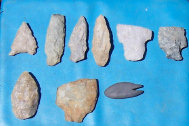
© Andy MartinDark forces at work
Where will astronomers stop in their love affair with the enigmatic substance called dark matter? First we were told it was essential to allow a galaxy to spin without falling apart. Then it was the glue that held clusters of galaxies together. Later it was said to have catalysed the formation of the galaxies in the first place. Now, surely, they have gone too far. If the latest theories pan out, dark matter has also given us some of the world's most enduring astrological myths.
In this rational age, we have come to recognise constellations as chance alignments of groups of stars. No longer do we think of Orion as a mighty hunter, brought down by the sting of a fateful encounter with the scorpion Scorpius. Yet it seems that an unseen hand may after all have been responsible for placing these stars in the sky.
Hints are emerging that around 30 million years ago, a giant clump of dark matter struck our part of the Milky Way, creating a rippling disc of star formation that eventually produced Orion's belt, the bright ruby jewel of Antares in Scorpius, and many more of the sky's most notable stars. If the scenario is correct, it could guide us in the search for a solution to one of the abiding mysteries of physics: what exactly is dark matter made of?
In the middle of the 19th century, the English astronomer John Herschel noticed that we are surrounded by a ring of bright stars. But it was Boston-born Benjamin Gould who brought this to wider attention in 1874. Gould's belt, as it is now known, supplies bright stars for many famous constellations including Orion, Scorpius and Crux, the Southern Cross, which appears on the official flags of five countries and several territories. Perseus and Canis Major in the north, along with Vela and Centaurus in the south, also contain stars in Gould's belt.










